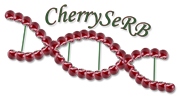Work packages
WP1 performs S-genotyping actions in support of WP2 and WP3, and investigates GSI-status in autochthonous cherry genotypes by: i) determining of S-haplotypes; ii) assigning of sweet cherries to their corresponding IGs (to known or new IGs); iii) determining the level of self-(in)compatibility in sour cherries.
WP1 performs S-genotyping actions in support of WP2 and WP3, and investigates GSI-status in autochthonous cherry genotypes by: i) determining of S-haplotypes; ii) assigning of sweet cherries to their corresponding IGs (to known or new IGs); iii) determining the level of self-(in)compatibility in sour cherries.
WP2 aims to provide:
- Assessment of the pollen-pistil interaction in relation to: i) S-haplotypes; ii) flowering temperature;
- Defining suitable polleniser(s) for autochthonous cherry genotypes;
- Defining the protocol for the choice of suitable polleniser for sweet and sour cherry genotypes;
- The part of a plant material in support of WP3.
WP3 aims to provide:
- Assessment of ovule longevity in relation to flowering temperature under i) field conditions; ii) laboratory conditions (higher temperatures);
- Assessment of ovule longevity in relation to different emasculation (emasculated/non-emasculated) and pollination (pollinated/non-pollinated) modes;
- Assessment of pollen performance in vitro under different temperature regimes;
- Defining ʻgood reproductive behaviour modelʼ of cherry genotype capable to face higher temperature conditions during the flowering.
WP4 aims to reveal potential of autochthonous cherry genotypes in terms of pomological and fruit quality attributes, as well as nutritional and health-promoting compounds, from the aspects of: i) using the genotypes of high-quality fruits in breeding work; ii) possibilities for future encapsulation of the extracts with the best health-related properties; iii) obtaining premium-quality fruits suitable for fresh consumption and processing in commercial cherry growing.
WP5 performs different communication and dissemination activities in order to increase impact of the project in both horizontal and vertical way, which will be directed toward: i) scientific community; ii) main stakeholders; iii) decision-makers at institutional level.
WP6 aims to ensure: i) at the operational level − the project progress in accordance to the work plan and with regard to overall progress, milestones and deliverables; ii) at the organizational level − management the financial, logistics, information issues and risks, in accordance to Science Fund rules and procedures.
